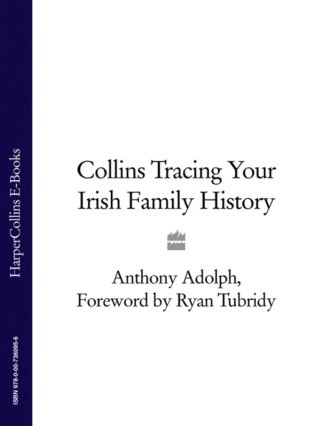
Полная версия
Collins Tracing Your Irish Family History
Thanks to the Great Famine, the workhouses were overflowing by autumn 1845. Disease became rife, and the way to the workhouse became known as Cosan na Marbh – ‘the pathway of the dead’. Up to 25 per cent of those admitted died, along with many staff: even Lord Lurgan, chairman of the Lurgan Board of Guardians of the Poor, succumbed to fever in 1847. In 1848, outdoor relief was adopted again, but for many it was far too late.
Workhouse records
The few workhouse records that survive are available on MMF, as catalogued in Ryan (see p. 9) and detailed in D. Lindsay and D. Fitzpatrick, Records of the Irish Famine, a Guide to Local Archives, 1840–55 (Dublin Irish Famine Network, 1993). See also J. O’Connor, The Workhouses of Ireland (Anvil Books, 1995). PRONI has records from 27 Unions, 1838–48; those for Eire are in local archives, with Co. Mayo’s at NLI. Records include birth and death registers, punishment and admission records – the latter stating name, gender, age, marital condition, family relationships, denomination, townland and date of departure (often actually the date of death). See also http://www.askaboutireland.ie/search.do?search_string=workhouses.
For a key to abbreviations used, see p. 9.
The Irish Diaspora
Emaciated, rag-clad and tinged green by starvation, with an average life-expectancy of 19 years, the stark choice faced by many Irish people during the Great Famine in 1845 was migrate, or die. Some 1.5 million people left for America, 340,000 for Canada, 300,000 for mainland Britain and 70,000 for Australia. Large numbers sailed west in ‘coffin ships’, unseaworthy vessels pressed into service by necessity and the owners’ venality. Some ships sank as soon as they had left port and others far out at sea. Passengers typically were unable to afford enough supplies, or had no idea the voyage could take 4–6 weeks, so many starved, and disease was rife.
They left behind a debilitated population, most of whom yearned to escape. Though the exodus slowed after 1855, migration had become a normal expectation. Many left due to terrible weather and crop failures between 1879 and 1888. Uniquely in Europe, Ireland’s population shrunk, from 8 million in 1841 to only 4 million in 1921. By 1891, 43 per cent of living Irish-born people were resident abroad. It is only in the last couple of decades that Ireland’s ‘Tiger’ economy has improved and immigration has started to reverse the trend.
The famine migrants belong to a much broader trend of emigration, due mainly to English interference and economic depression, starting with the Wild Geese (see p. 207) in the 17th century and only effectively ending a few decades ago. The legacy of 400 years’ emigration is that an estimated 70 million people living outside Ireland have Irish roots. Because the famine drove both genders to migrate in equal numbers, fully-Irish communities were established all over the world. Equally, many of the estimated 70 million have some Irish ancestry mixed in with much other blood.
Much depends on perception: descents from downtrodden groups, such as Jews or black slaves, have become marks of proud distinction, to be sought after in otherwise dull family trees. And, far from being synonymous with terrorism, as it was 20 years ago, Irishness has resumed its gorgeous ancient mantle, velvet green shot through with gold, of Gaelic myth and folk music, topped up by the music of The Pogues and the successful marketing campaigns of Guinness. Its best synonym now is the craic of St Patrick’s night, so no wonder people with only the slenderest strand of Gaelic blood today proudly call themselves ‘Irish’. Consequently, when the English 2001 census allowed, for the first time, people to choose ‘Irish’ as the best description of their ethnicity, the figure for people in England with Irish origins leapt from 10 per cent (1991) to 25 per cent!
The true number of people with Irish roots is still unknown. But I know one thing for sure: the more people dig into their family past, the more Irish roots will be uncovered.
FURTHER READING
A. Bielenberg (ed.), The Irish Diaspora (Longman, 2000), contains fascinating articles on many of the countries where the Irish settled.
Irish Diaspora website: www.irishdiaspora.net.
Конец ознакомительного фрагмента.
Текст предоставлен ООО «ЛитРес».
Прочитайте эту книгу целиком, купив полную легальную версию на ЛитРес.
Безопасно оплатить книгу можно банковской картой Visa, MasterCard, Maestro, со счета мобильного телефона, с платежного терминала, в салоне МТС или Связной, через PayPal, WebMoney, Яндекс.Деньги, QIWI Кошелек, бонусными картами или другим удобным Вам способом.






